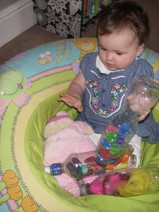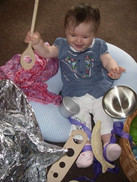Treasure baskets - help your baby to learn through play...
- Donna

- May 31, 2022
- 4 min read
Updated: Mar 29, 2023
And save some space in your living room!
Treasure baskets build on the educational principle of heuristic play.
HEURISTIC: adjective: involving or serving as an aid to learning, discovery, or problem-solving by experimental and especially trial-and-error methods.
Education: Of or relating to an educational method or resource that enables students or children to learn by making discoveries for themselves, rather than being directed.
What Is Heuristic Play?
The term was originally defined by Goldschmied and Jackson in their 1994 book People Under Three, and has since become a recognised activity and learning method in many early years settings (Huleatt, 2015). Heuristic play utilises a child’s own natural curiosity and sense of exploration when presented with a selections of objects to investigate, interrogate and explore. Treasure baskets or collections of everyday objects are provided and play is led by the child very little adult intervention, allowing children to make choices and discoveries on their own (Jackson & Forbes, 2015).
How Does Heuristic Play Support Development?
Throughout the first year of their life, a baby will go through a number of developmental leaps that enable them to learn about their environment and the world around them. As a baby grows, they begin to look at the world around them with more interest, initially content with feeling and touching objects they soon move onto a desire to manipulate and experiment with them; filling them, building with them, stacking them, inserting them, threading them, fitting them together, and making sounds with them. When they make a discovery they may repeat it multiple times; this develops cognitive ability, motor skills and hand/eye co-ordination. In addition to this as they grow children will be building on and enhancing personal, social and emotional development, communication, language and problem-solving skills (Rijt & Flooij, 2010).
Treasure baskets are a good way of introducing the concept of heuristic play with babies and children from a very young age. A treasure basket is simply a collection of household and natural objects contained in a basket or box generally made of wicker or other natural materials. The objects must be baby safe with no loose or sharp elements.
You can begin to create a treasure basket before your baby is born selecting objects that have significance or meaning, and thinking about what might grab your baby's attention. Or you can ask friends and relatives to gift your baby an item for their treasure basket, perhaps as part of a Mother Blessing or baby shower.
Creating a treasure basket gives you the opportunity to think about how your baby will explore objects and view the world, gives some focus for the time you spend with your baby and supports your developing relationship and communication.
A treasure basket offers the opportunity for a baby to choose what they want to investigate and promotes concentration, these are valuable and essential skills. Even babies who are not yet able to crawl can derive a great deal of stimulation from the opportunity to explore a treasure basket (Riddall-Leech, 2009).
Why Treasure Baskets Are Good for Parents
"No need to spend lots of money on pre made baskets, when most items live in your own home, or if you need to buy extra items it wont break the bank."
Doula Magic Client talking about the treasure basket they helped her create.
As parents treasure baskets offer a few big advantages over more common and popular toys:
Cheap to create, whether you use existing items from your home, or pick up a few bits from the shops, they can be relatively inexpensive.
They don't take up much space, this means they can easily be tidied away and tucked in a cupboard/corner/under the sofa. Your living room looks a whole lot nice on a evening when you get to sit down for a bit if its not full of baby paraphernalia.
Quiet - a treasure basket doesn't play music, or sing songs, or make odd noises, sometimes this can be just what you need as a parent a little moment of calm and quiet.
You can switch things up and swap items around to keep your babies interest in the treasure basket.
When you baby is done with your treasure basket items they can be repurposed into house hold use.
If you are going away, treasure baskets are easy to transport, take the whole thing or a few favourite items.
Your baby/child will always be able to find something to play with wherever you go. They are used to exploring objects and investigating items, so wherever you go you'll be able to find something to entertain them.
Treasure baskets build your babies core physical and social skills and help them learn about the world, helping them to understand and communicate with those around them.
Sitting alongside your baby and mirroring their play build trust, enhances communication, and develops your relationship.
They give you something to do with your baby. Sometimes its hard to find activities to entrain babies and young children, a treasure basket offers the opportunity to play with your baby.
No batteries required.
Remember that babies and young children should always be supervised when playing with treasure basket items to ensure they are using items safely.
Some Treasure Basket Ideas
Natural objects: fir cones, big shells, large walnuts, pumice stone, fruit (apple, lemon, orange), fresh herbs, stones, shells
Objects made from natural material: woollen ball, little baskets, brushes (test bristles are firmly attached)
Food: pasta, cereal, fruits, vegetables.
Wood: rattles, spoons, egg cups, bowls, pegs, napkin rings
Metal: spoons, tin lids, tea strainer, garlic press, bunch of old keys
Think about themed treasure baskets for example: Christmas, bathroom, kitchen, different textures, wooden things, shiny things, smelly things
How can the PBY Cheshire team help you?
Within Pregnancy, Baby & You Cheshire we have a few people who are happy to help you with your treasure basket queries, give you some ideas or pointers on where to start, so check out the directory or come and meet us at one of our friendly, relaxed and informal PBY Cheshire Pudding Clubs!
Where to get more information
Huleatt, H. (2015) Heuristic play. [Online] Available from: https://www.communityplaythings.co.uk/learning-library/articles/heuristic-play [Accessed 31/05/2022].
Goldschmied, E & Jackson, S. (1994), People Under Three: Young Children in Daycare. 1 st Edition. London, Routledge
Jackson, S., & Forbes, R. (2014). People Under Three: Play, work and learning in a childcare setting (3rd ed.). Routledge. https://doi.org/10.4324/9781315815275
Riddall-Leech, S. (2009) Heuristic Play: play in the EYFS. 1st Edition. London, MA Education Ltd.
Rijt, H. & Flooij, F. (2010) The Wonder Weeks. 2nd edition. The Netherlands, Kiddy World Productions B
















Comments